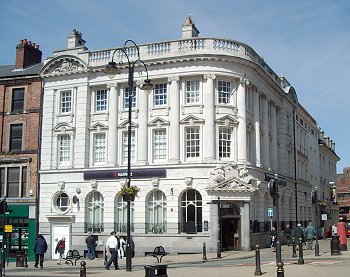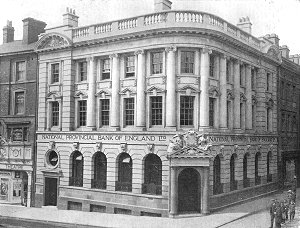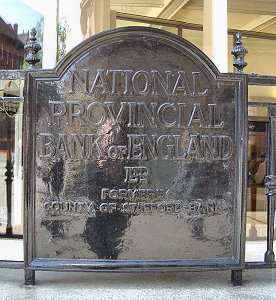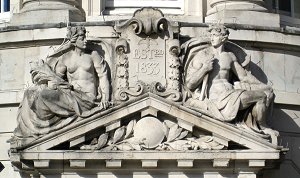|

Listing: c.1905. Edwardian Baroque style.
Literature:
Anthony Perry, "St. Peter's House", St. Peter's Collegiate
Church, 1998.
The Builder, Nov.26th, 1920, p.604
Comment:
"The Builder" gives the architects as Bromley & Watkins. (Does
anyone know anything about them?)
The date stone on the building refers to the date of the bank's
founding, not the date of this building. The statutory listing has
also got the date wrong - presumably they guessed a date from the style;
and it would seem, on that basis, a pretty accurate guess. But in
fact there is an application for Building Bye-Laws approval, in the city
archives, dated 1913, so Anthony Perry's date of 1914 is clearly right.
He writes (op.cit. p18): "In 1914 the National Provincial Bank, now
National Westminster, was built in its present grand style at the corner
of Exchange Street and the Square. The strange frontage to Exchange
Street beyond the main bank building can be explained by this new
development. The three and a half storey red brick building with stone
stressing and parapet, the top storey having round windows, originally
continued all the way along to the corner of the Square, where the
premises of S. Cole, Cash Draper, occupied the shop frontage. This
complemented the other corner building, now Consorts [and now a coffee
shop under another name!]. When the bank was rebuilt to include Cole's
shop, the back part of the older building was left".
The Builder (long after the event but probably based on information
from someone connected with the building) records that increasing
business necessitated the pulling down of the bank's old building and
the erection of a new one with "considerable extensions" - which would
be the part along Exchange Street. They also mention basement
strong rooms and a ground floor treasury. The upper floors,
"provided with an electric lift", have access from the door to the left
side of the building and were sublet for offices.
 |
Photo of about 1914. Note
that to the far left you can just see part of the Electric
Theatre (a cinema) which operated under that name until 1915
when it became the Imperial Playhouse (see Ned Williams,
Cinemas of the Black Country, at p.48). |
| This photo of the interior is of
about the same date. The design is unexceptional but
the counter grilles are of some interest in that they were
made by Colledge and Bridgen, Midland Works, Wolverhampton -
a firm more usually known as lock manufacturers.
|
 |
 |
When this building was put up it
was for the National Provincial Bank of England. This cast
iron plaque, in the original railings, says "Formerly County of
Stafford Bank". Presumably that was a local bank which was one
of those which became part of the National Provincial. |
| The sculpture over the corner
entrance, showing the date 1833 - but note that it says
"Ested 1833" which is, presumably, the foundation date
claimed by the Nat Prov rather than the County of Stafford
Bank. |
 |
Noszlopy and Waterhouse, Public Sculpture of Staffordshire and the
Black Country, at p. 204, say, of the sculpture over the main door, that
the sculptor is unknown and that the male figure, with a sledgehammer,
personifies industry; and the female figure, with a bundle of wheat,
personifies agriculture. "Behind the figure of Industry
there is a beehive, the traditional symbol of a bank; in heraldry, the
bees themselves symbolise a well-governed industry". "The Builder"
says that the sculpture is "symbolical of local industries" but does not
say who designed it - as like as not it was the architects.

|